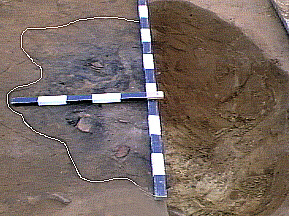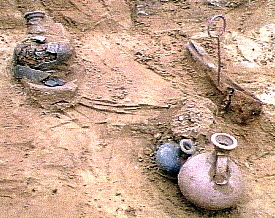
Fig. 3 Ash pit containing the remnants of a pyre at Kehlen-Rennpaad.
At first sight, the present territory of the Grand Duchy of Luxembourg may seem to be particularly favoured as regards the tradition of archaeological research, since the first scientific observations available concerning the excavation of burial sites date as far back as the third quarter of the 17th century. They are attributable to a Jesuit father, Alexandre Wiltheim. (1604-1684), who was director of the Jesuit college of Luxembourg, an antiquarian and an historian. In his main work, the "Luciliburgensia Romana sive Luxemburgum Romanum" he devotes an important place to burial finds and funerary monuments. For information on Wiltheim, the Wiltheim family and the works of A. Wiltheim, particularly his "Luxemburgum Romanum", see Krier and Weiller 1984; Krier and Thill 1984; and Ternes and Polfer 1997.
After the death of Wiltheim in 1684, however, there was no continuation of his scientific work. It was not until the middle of the 19th century and the creation of the Société pour la recherche et la conservation des monuments historiques (Society for Research into and Conservation of National Historic Monuments) that a reawakening of scientific interest in archaeology in general, and the excavation of burial sites in particular, occurred in Luxembourg.
Luxembourg's Société pour la Recherche et la Conservation des Monuments Historiques was founded on 2 September 1845. The fact that it was to be commonly known from the outset as the Société archéologique du Grand-Duché de Luxembourg (archaeological society) clearly indicates the important if not primary role of archaeological research among its various activities. It is to the work of the society, which in 1869 became the Section Historique de l'Institut Grand-Ducal (Department of History) (Goedert 1987), that we owe much of the information available today on the excavation of Gallo-Roman burial sites in the Grand Duchy of Luxembourg.
From the first year of its existence the Société archéologique began to began to build up a collection of objects, mostly funeral objects, which today constitutes the basis of the collections of the Musée National d'Histoire et d'Art (MNHA).
More importantly for our purpose, from the outset the Société archéologique published an annual bulletin, now commonly called the Publications de la Section Historique (Historical Department Publications). The curator's annual reports published therein, listing the digs carried out by members or corresponding members of the society, chance finds reported to the society and objects donated to or bought by the society, constitute an invaluable source of information. Lastly, the archaeological society's archives, now partly conserved in the MNHA, contain in unpublished material (letters, memoranda, opinions) a wealth of information on Gallo-Roman tombs or cemeteries discovered on national territory.
This society's Publications de la Section historique (Historical section publications) also included the first research into Gallo-Roman tombs in Luxembourg. Between 1851 and 1856 Professor J. Engling (Engling 1851; 1852; 1853) devoted a three-part study to tumuli in the Grand Duchy. His colleague, A Namur, also published a two-part study in 1852 and 1860 devoted to "Gallo-Frankish" tombs (Namur 1852 and 1860 In 1861 Engling devoted a study to the oldest "Christian" (i.e. inhumation) tombs in Luxembourg (Engling 1861).
While it is thanks to the work of the Société archéologique that we have a considerable wealth of valuable information, it is well known that the type of 19th century documentation has created difficulties for present-day researchers. Interested in objects rather than archaeological context, the writers of old excavation reports only rarely provide more or less precise information on the organization of cemeteries, the exact number of tombs excavated, etc. As most of the reports published do not contain illustrations, it is often difficult, not to say impossible, to verify any dates given.
The creation of a Musée d'Etat du Grand-Duché de Luxembourg (http://www.men.lu/musee/ ) (national museum) now the Musée National d'Histoire et d'Art (National Museum of History and Art), responsible for conducting official archaeological research, did not alter the situation in any way for a long time.
Although there were occasional ventures into the excavation of Gallo-Roman burial sites between the two world wars and in the immediate post-war period, they are no better documented than excavations by amateurs in the 19th century. It was not until the 1960s that the decisive step towards scientific archaeology was taken in Luxembourg. It was with the excavation and publication in 1963 of the Goeblingen-Nospelt tombs (Metzler 1984) then in 1968 and 1969 of the neighbouring cemeteries of Nospelt-Tonn (Thill 1968) and Nospelt-Kreckelbierg (Thill 1969) that the excavation of burial sites in accordance with modern scientific methods made its appearance in the Grand Duchy.

Fig. 3 Ash pit containing the remnants of a pyre at Kehlen-Rennpaad.

Fig. 4 Cremation tomb containing several jars and iron scissors. 1st century AD, from Kehlen-Rennpaad.
Since the 1960s, excavations and publications concerning Gallo-Roman cemeteries, individual tombs or funerary monuments constitute one of the main aspects of the work carried out by the archaeological department of the Musée National d'Histoire et d'Art.
To sum up, it must be said that if scientific research on the excavation of burial sites had already began in the second half of the 17th century, it remained the preserve of more or less enlightened amateurs for longer than elsewhere in Europe. Of course, this was not without consequences for the basic documentation available to us today for the study of Gallo-Roman funeral rites.
© Internet Archaeology
http://intarch.ac.uk/journal/issue4/polfere/5polfere.html
Last updated: Tue Dec 09 1997